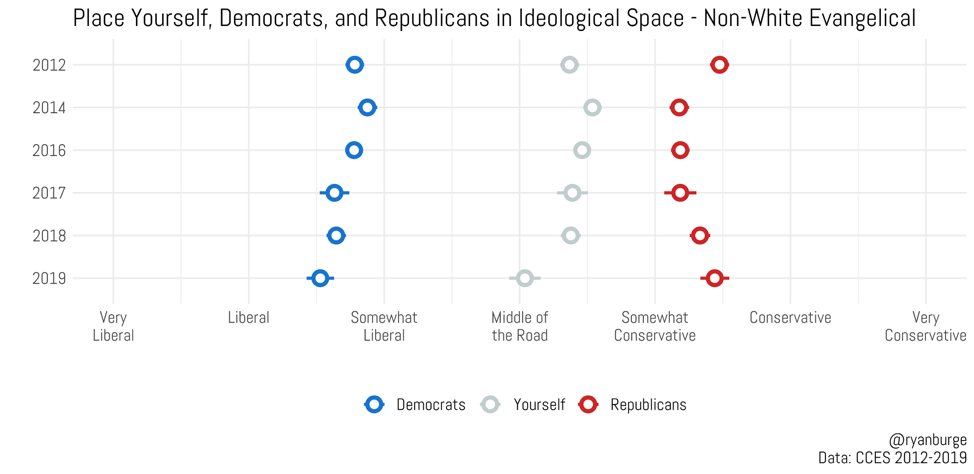How liberal are Republicans? How conservative are Democrats? Here's what religious Americans think
(ANALYSIS) It’s become a very overwrought cliché, but it applies perfectly to the political world: “perception is reality.” One of the vexing problems in political science is a fairly basic one: how do people perceive the political world around them? And then, how do they perceive their position relative to those other actors in the political space?
It’s clear that Donald Trump wanted to paint Joe Biden and the Democratic party as “radical socialists” in the 2020 election. In the first debate that was made clear during this exchange:
TRUMP: "Your party wants to go socialist medicine.”
BIDEN: "The party is me. Right now, I am the Democratic Party."
However, it does seem like Trump’s attempt to paint Biden as an extremist did pay off in places like Miami-Dade county, where large shares of Hispanics abandoned him.
But, how effective is messaging like that? Is the public consistent about where it places the Democrats and the Republicans? Does that vary by religious groups? Fortunately, the CCES has been asking respondents to place themselves and the two major parties on a scale from very liberal to very conservative since 2019. What emerges is a fascinating story of how religion, partisanship and race interact to generate a fairly consistent portrait of the political world.
To speak in broad strokes initially - the public is remarkably good and consistently able to place the parties in a reasonable position in the ideological spectrum. Notice that Democrats are always placed to the left of center and Republicans to the right. But also it’s worth mentioning how solid that position is over the last seven years - when shifts do happen they are subtle. Which means that Americans have relatively firm views of partisan space.
But, their views of where they themselves are found in that policy space is surprisingly consistent. Especially in the case of larger religious groups, the movement is incremental and doesn’t jump back and forth every year. These results should provide some comfort to us - the public doesn’t view the political landscape or their place in it as volatile year to year.
However, there are a few groups that are worth zooming in on, because they tell an interesting story about how things have shifted since 2012.
White evangelicals are a good place to start. First, their placements of the Democratic Party are noteworthy. The picture that emerges is consistent - they see the Democratic Party as becoming increasingly liberal over time. At the same time, they see the Republicans occupying the same space on the right. But, and this is key, white evangelicals see no distance between themselves and the Republican party - they are in lock step. They are the base of the party, and they know that, which can have profound implications for the Republican Party as it moves forward.
Comparing white evangelicals to nonwhite evangelicals elucidates a fascinating difference. First, nonwhite evangelicals see the Democratic Party as being much more moderate than their white counterparts. However, they do see Democrats drifting away from the center. At the same time, nonwhite evangelicals believe that the Republican Party has become more conservative beginning in 2017. In fact, the biggest shift happened between 2018 and 2019. Non-white evangelicals thought of themselves as right of center, then in 2019 they placed themselves right in the middle of the spectrum and equidistant from both parties. They see themselves as not wed to either side.
Of all the religious groups that appeared in the first figure, the one that clearly stands out is atheists. In some ways, they are mirrored opposites of white evangelicals. They see the opposing party (in this case Republicans) as becoming increasingly extreme. However, atheists have a different view of Democrats. They see the Democrats as being much more moderate than any other religious group does. But atheists also seem convinced that they are more liberal than the Democrats. This divide only widened in 2019.
Taken together, we have an interesting story that emerges. White evangelicals think that Democrats are incredibly liberal, but atheists see them as just slightly left of center. All this comes down to an issue of anchoring. There are no fixed points in political space - what is liberal to one person is seen as mainstream by someone else. Thus, politicians are able to exploit the fluidity of political concepts to paint the other party as extreme, while at the same time, they believe that their party is moderate and full of common-sense ideas.
If anything, these results add another piece of evidence to the “GOP Gap” and further describe the increasing polarization of religious groups in the United States. It’s hard to compromise when religious groups and political parties cannot even agree to the broad definition of a moderate, middle-of-the-road policy compromise.
Ryan Burge is an assistant professor of political science at Eastern Illinois University, a pastor in the American Baptist Church and the co-founder and frequent contributor to Religion in Public, a forum for scholars of religion and politics to make their work accessible to a more general audience. His research focuses on the intersection of religiosity and political behavior, especially in the U.S. Follow him on Twitter at @ryanburge.




